
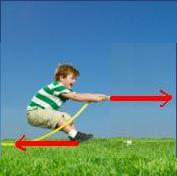


The children are all pulling on the rope, but nothing is happening.
According to the Law of Inertia, each
person and each part of the rope must be experiencing balanced forces. For
example, the rope is pulling on Billy, and the ground is exerting a force
on Billy.
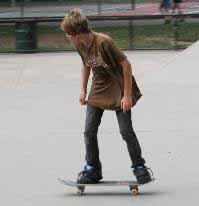
A skateboard rolls at constant speed. The Law of Inertia applies here, and
implies that the forces on the skateboard balance. The boy's
weight (a downward force) is canceled by an upward force exerted by the ground. There are no
sideways forces (we're ignoring the small friction force that will eventually
bring him to a stop).
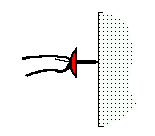 When you push a thumbtack into a board, it moves at a constant (and very small)
speed. The according to the Law of Inertia, the forces on the thumbtack are
in balance.
There are two large forces acting on the thumbtack: the force of the finger pushing
the thumbtack to the right, and the force of the board, pushing the thumbtack to the left. According to the Law of Inertia, these forces are equal and opposite.
When you push a thumbtack into a board, it moves at a constant (and very small)
speed. The according to the Law of Inertia, the forces on the thumbtack are
in balance.
There are two large forces acting on the thumbtack: the force of the finger pushing
the thumbtack to the right, and the force of the board, pushing the thumbtack to the left. According to the Law of Inertia, these forces are equal and opposite.
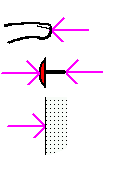 To simplify the picture, physicists like to separate the parts of the system,
and show the forces acting on the parts separately. Then the drawing above becomes
the three diagrams at left.
At the top, we show the force of the tack on the finger; in the middle, the force of the
finger on the tack and the force of the board on the tack (which are the two forces
that balance); at the bottom, the force of the tack on the board.
The Law of Interaction relates the different diagrams: the force of the tack on the
finger is equal (but opposite to) the force of the finger on the tack, and the force of
the tack on the board is equal (but opposite to) the force of the board on the tack.
To simplify the picture, physicists like to separate the parts of the system,
and show the forces acting on the parts separately. Then the drawing above becomes
the three diagrams at left.
At the top, we show the force of the tack on the finger; in the middle, the force of the
finger on the tack and the force of the board on the tack (which are the two forces
that balance); at the bottom, the force of the tack on the board.
The Law of Interaction relates the different diagrams: the force of the tack on the
finger is equal (but opposite to) the force of the finger on the tack, and the force of
the tack on the board is equal (but opposite to) the force of the board on the tack.
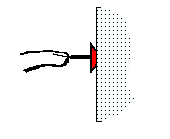
Combining these relationships we find that the force of the tack on the finger is equal to the force of the tack on the board. This may seem peculiar: after all, it does make a difference which way the tack is pointing! . However, the difference involves a different concept.
The chapter on balanced forces